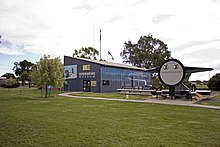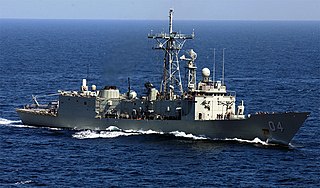
HMAS Darwin, named for the capital city of the Northern Territory, was an Adelaide-class guided-missile frigate, formerly in service with the Royal Australian Navy (RAN). One of four ships ordered from the United States, Darwin entered service in 1984. During her career, she has operated in the Persian Gulf, as part of the INTERFET peacekeeping taskforce, and off the Solomon Islands. The frigate underwent a major upgrade during 2007 and 2008. She was decommissioned on 9 December 2017 and was supposed to be scuttled as a dive wreck in Tasmania, but the deal was pulled by the Tasmanian Government and her fate remains uncertain.

HMAS Newcastle, named for the city of Newcastle, New South Wales, the largest provincial city in Australia, was an Adelaide-class guided-missile frigate. The last ship of the class to be constructed, Newcastle entered service with the Royal Australian Navy in 1993. During her career, the frigate has operated as part of the INTERFET peacekeeping taskforce, served in the Persian Gulf, and responded to the 2006 Fijian coup d'état. The frigate was decommissioned on 30 June 2019 and transferred to the Chilean Navy on 15 April 2020 and renamed as Capitán Prat.

HMAS Farncomb is the second of six Collins-class submarines operated by the Royal Australian Navy (RAN). Named for Rear Admiral Harold Farncomb, the submarine was laid down in 1993 and launched in December 1995—the first submarine to be completely constructed in Australia. A combination of factors led to Farncomb being the only vessel of her class in operational condition in mid-2009.

HMAS Dechaineux is the fourth of six Collins class submarines operated by the Royal Australian Navy (RAN).
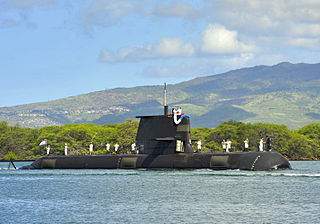
HMAS Sheean is the fifth of six Collins-class submarines operated by the Royal Australian Navy (RAN).
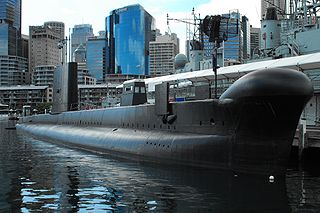
HMAS Onslow is one of six Oberon-class submarines, decommissioned in 1999 and previously operated by the Royal Australian Navy (RAN). The submarine was named after the town of Onslow, Western Australia, and Sir Alexander Onslow, with the boat's motto and badge derived from Onslow's family heritage. Ordered in 1963, Onslow was laid down at the end of 1967 by Scotts Shipbuilding and Engineering Company in Scotland, launched almost a year later, and commissioned into the RAN at the end of 1969.
HMAS Orion was an Oberon class submarine of the Royal Australian Navy (RAN). One of six submarines ordered by the RAN during the 1960s, Orion, named after the constellation in a break from ship-naming tradition, was built in Scotland and commissioned in 1977. Orion was one of two Oberon-class submarines designed for intelligence gathering and conducted regular patrols in Soviet, Indian and Chinese waters to gather information regarding enemy capabilities.

HMAS Otama was an Oberon-class submarine of the Royal Australian Navy (RAN). Built in Scotland, the submarine was the last of the class to enter service when commissioned into the RAN in 1978. Otama was a specialist, one of two "Mystery Boats", fitted with additional surveillance and intelligence-gathering equipment. Otama was routinely deployed on classified operations to obtain intelligence on Soviet Pacific Fleet vessels and Chinese Navy vessels, and conducted associated coastal surveillance, throughout Asia.
Two submarines of the Royal Australian Navy (RAN) have been named HMAS Otway.

HMAS Ovens was an Oberon-class submarine of the Royal Australian Navy (RAN). She was one of six Oberons built for the Royal Australian Navy by the Scottish Scotts Shipbuilding and Engineering Company, and entered service in 1969. The vessel was named for Irishman and Australian explorer John Ovens (1788–1825) and for whom the Victorian river Ovens was named. During her career, Ovens was the first RAN submarine to deploy with the ANZUK force, and the first RAN submarine to fire an armed Mark 48 torpedo, sinking the target ship Colac. The boat was decommissioned in 1995, and is preserved at the Western Australian Maritime Museum as a museum ship.

HMS J5 was a First World War J class submarine operated by the Royal Navy and the Royal Australian Navy.
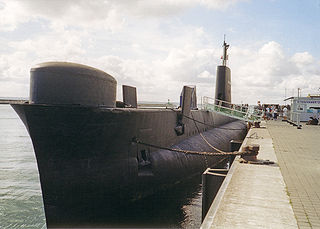
The Oberon class was a ship class of 27 British-designed submarines operated by five nations. They were designed as a follow-on from the Porpoise class; physical dimensions were the same but stronger materials were used in hull construction and improved equipment was fitted.

HMS Oberon was the lead ship of the Oberon-class submarines, operated by the Royal Navy.

HMAS Melbourne was an Adelaide-class guided-missile frigate of the Royal Australian Navy, which entered service in 1992. Melbourne has been deployed to the Persian Gulf on several occasions, and served as part of the INTERFET peacekeeping taskforce in 2000. On 26 October 2019, Melbourne was decommissioned from the RAN, subsequently being transferred to Chile. The ship was commissioned into the Chilean Navy as Almirante Latorre on 15 April 2020.

HMAS Vampire was the third of three Australian-built Daring class destroyers serving in the Royal Australian Navy (RAN). One of the first all-welded ships built in Australia, she was constructed at Cockatoo Island Dockyard between 1952 and 1959, and was commissioned into the RAN a day after completion.

The Royal Australian Navy Submarine Service is the submarine element of the Royal Australian Navy. The service currently forms the Navy's Submarine Force Element Group (FEG) and consists of six Collins class submarines.

HMS Otway was an Odin-class submarine of the Royal Australian Navy (RAN) and Royal Navy (RN).

HMS Oxley was an Odin-class submarine of the Royal Australian Navy (RAN) then Royal Navy (RN). Very slightly off course, near Obrestad, on the south-western cape of Norway, she was hit by friendly fire seven days after the start of World War II costing 53 lives and leaving two survivors.

HMAS Oxley was an Oberon class submarine of the Royal Australian Navy (RAN).
HMAS Platypus is a former Royal Australian Navy (RAN) submarine base, located at 118 High Street, North Sydney with moorings in Neutral Bay, a suburb of Sydney in New South Wales, Australia. It was located upon the site of the Royal Australian Navy Torpedo Maintenance Establishment (RANTME), it built on the site of the former North Sydney Gas Works that operated on the site from 1877 and resumed by the Commonwealth in 1942. The Fleet Intermediate Maintenance Activity (FIMA) Workshops building on the site was originally used for torpedo assembly and storage during World War 2. It was later modified for submarine maintenance and repair, with a steel tower added to the northern end of the building for testing, cleaning and maintenance of periscopes.

